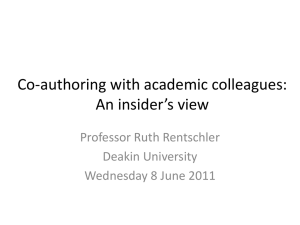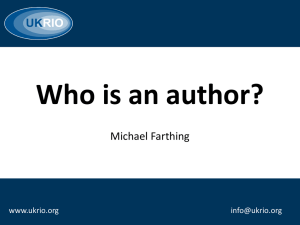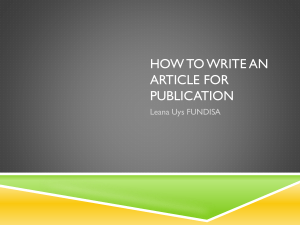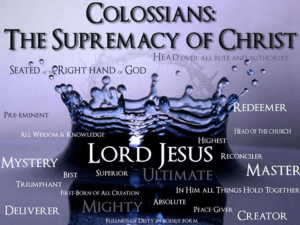authors
advertisement
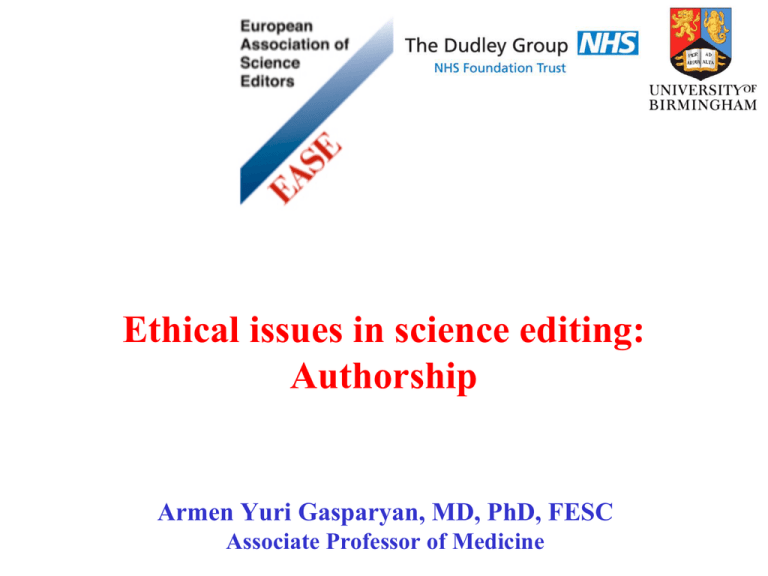
Ethical issues in science editing: Authorship Armen Yuri Gasparyan, MD, PhD, FESC Associate Professor of Medicine Associations concerned with authorship problems • An online site, 75% of people polled believe that Einstein’s wife, Mileva Maric, contributed to his works of 1905 (Annus Mirabilis’ 4 papers published in Annalen der Physik) • Nobel Prize in Physics in 1922 • Foundation of modern physics Definition Who are the authors (old criteria) 1. Those who provide substantial contributions to conception and design, data acquisition, or analysis and interpretation of data 2. Those who involved in document drafting or provide critical review for important intellectual content 3. Give final approval of publication http://www.icmje.org/ethical_1author.html The main principle of authorship in biomedicine Creativity! Who do NOT qualify as authors • Those who only secure funding for research • Those who only [perform lab tests]/collect data • Those who only supervise the [research] project • Those who provide writing assistance http://www.icmje.org/ethical_1author.html Other criteria Authorship implies a significant intellectual contribution to the work, some role in writing the manuscript and reviewing the final draft of the manuscript, but authorship roles can vary. Who will be an author, and in what sequence, should be determined by the participants early in the research process, to avoid disputes and misunderstandings which can delay or prevent publication of a paper. Other criteria American Physical Society guidelines authorship ... limited to ... a significant contribution to the concept, design, execution or interpretation of the research study. All those who have made significant contributions should be offered the opportunity to be listed as authors. Other individuals who have contributed to the study should be acknowledged, but not identified as authors. http://www.aps.org/policy/statements/02_2.cfm Other criteria Ecological Society of America authorship may legitimately be claimed if researchers: • conceived the ideas or experimental design; • participated actively in execution of the study; • analyzed and interpreted the data; or • wrote the manuscript http://esapubs.org/esapubs/ethics.htm Unresolved issues • Can merely data collection or statistical analysis, or professional writing justify authorship? • Should each author be familiar and able to defend entire scholarly work? • Should all co-authors be equally responsible for misinformation or ethical misconduct? • Should editor be held responsible for inappropriate authorship? First author in by-lines • Usually junior researcher • Make the greatest contribution to the work Equal authorship • Those who equally contributed to the study • Usually first and second authors • No clear definition • May be used for academic promotion Last author in by-lines • Usually senior researcher • Head of the department, often corresponding author • Guarantor of the integrity of the whole research work who guide throughout research and writing • Sometimes ‘guest’ or ‘gift’ author Corresponding author • Responsible for receiving reviewers’ comments, the proofs, reprints, coordination of revisions and integrity of the whole work • Usually senior researcher • Contact details do not change over long period of time • Correspondence should include postal and electronic addresses, phone & fax • Valid and active email is a must Ghost author • Authors who made substantive contribution to the design, execution, revisions, meet the ICMJE criteria but not listed as co-authors • Representatives of pharma industry • Authors’ editors who are not listed in the acknowledgements (e.g. in case of editorials, reviews, rarely – original papers) • Denial of fair authorship - misconduct Gift author • Authors who do not meet the ICMJE criteria but listed as co-authors • Usually senior researchers, heads of the department, those who provided funding • A colleague who is expected to add your name in his articles without considering your contribution Inappropriate authorship • Ann Intern Med, JAMA, Lancet, Nature Med, N Engl J Med, PLoS Med • Corresponding authors surveyed with 30 questions about contributions of authors • In the sample (n=630) prevalence of honorary authorship, ghost authorship, or both was 21.0% (95%CI 18.0-24.3%) • Honorary authors for research articles 25.0%, reviews 15.0%, editorials 11.2% Honorary authorship • 3 major physical medicine and and rehabilitation journals (2009-2011) • Response 27% (248/908) Honorary authorship in Iran 89% in Iranian J Publ Health, J Kerman UMS, Tehran UM J Guest authorship in a top Iranian journal • N of authors fulfilling ICMJE criteria • 12 issues of AIM, 2005-2007 • Authors/article - 3.5 in 2005, 4.1 in 2006, and 5.6 in 2007 • 296 names evaluated: 186 (62.8%) met the criteria, 110 (37.2%) – ‘guests’ Ghajarzadeh M. Guest Authors in An Iranian Journal. Dev World Bioeth 2012 Oct 1. doi: 10.1111/dewb.12002. Global prevalence of honorary authorship • 72% in Am J Roentgenol Bonekamp S, et al. AJR Am J Roentgenol 2012;198:1247-55 • 14.3% in pharmacy journals, reaching 29.4% in articles authored by more than 5 authors Dotson B, et al. Am J Health Syst Pharm 2011;68:1730-4 Number of authors and their order • No regulations • Multi-authorship requires disclosures over contributions • Multi-authorship is time-consuming • Limits depend on article type (RCT report – no limits, reviews – 3-4, case – 2-3, editorial – 1-2) • Order is dependent on authors, their contributions and is resolved at the start • Types of order: descending order of contribution, alphabetical listing and random order How to avoid inappropriate authorship “Authors by self-regulation can comply with definitions of authorship” “Journals [editors] can outline the requirements for authorship and require a list of author contributions” “Institutions can educate and encourage good publication practices” Authorship statements in instructions Rheumatology category •44 journals •Statements on authorship - in only 13 (29.5%) •A specific reference to the renewed four criteria in only 8 (18.2%) instructions COPE flowcharts • Request to add extra author before publication http://publicationethics.org/files/u2/04A_Author_Add_Submitted.pdf COPE flowcharts • Request to remove author http://publicationethics.org/files/u2/04B_Author_Remove_Submitted.pdf COPE flowcharts • Suspected guest, gift and ghost authorship http://publicationethics.org/files/u2/04E_Author_Ghost_Guest_Gift.pdf COPE flowcharts • How to spot authorship problems http://publicationethics.org/files/u2/04F_How_to_spot_author_problems.pdf • Request for addition of extra author after publication http://publicationethics.org/files/u2/04C_Author_Add_Published.pdf • Request for removal of author after publication http://publicationethics.org/files/u2/04D_Author_Remove_Published.pdf Authorship problems • How to spot authorship problems http://publicationethics.org/files/u2/04F_How_to_spot_author_problems.pdf Long and short authors lists Tracking ‘guest’ and ‘gift’ authors Contributions statement • Most journals have this section • Each and every author’s contributions should be mentioned in detail http://www.councilscienceeditors.org/files/public/entire_whitepaper.pdf http://www.wame.org/resources/policies#authorship http://publicationethics.org/files/Research_institutions_guidelines_final.pdf http://www.singaporestatement.org/ Authorship criteria (2013) 1. 2. 3. 4. Substantial contributions to the conception or design of the work... Drafting the work or revising it critically... Final approval of the version to be published... Agreement to be accountable for all aspects of the work in ensuring that questions related to the accuracy or integrity of any part... http://www.icmje.org/roles_a.html Multi-authorship 1000 authors Authorship vs. contributorship Contributorship The current ICMJE guidance is a farce. Most authors do not meet the ICMJE guidance. Include as an author each person who contributed to any of the items listed by the ICMJE. Plus - each author’s role clearly state in a contributorship statement. Abbasi K. End the farce; a new approach to authorship. J R Soc Med 2012;105(9):361. Authorship index Points for certain activities are awarded: 1. Intellectual input (planning/designing/interpreting) – maximum 25 2. Practical input: data-capture - 25 3. Practical input: data processing/organizing - 10 4. Specialist input from related fields - 15 5. Literary input (first complete draft of manuscript) - 25 Passing a threshold score (25 out of 100 points) guarantees authorship Place in the bylines is based on scores Hunt R. Trying an authorship index. Nature 1991;352:187 Authorship index and the by-lines Points for certain activities are awarded up to 1.0 Contributions should be given in the by-lines after the authors’ names: Author A(0.4), B (0.3), C (0.2), D (0.1) Authorship points • • • • 1,000-point system The whole idea - 250 points Writing the whole paper - 250 points Full design, running experiments and analysing the data – 500 points • Researchers who score 100 points make the author list, with each person’s point total determining their rank Stephen Kosslyn, Stanford Uni, CA, USA Thanks for attention! Q&A a.gasparyan@gmail.com
